
entirely with that of the teeth of the living Lepi-
dosteus osseus. (PI. 27a, Figs. 1, 2, 3.)
Smaller Sauroid Fishes only have been noticed
in the Magnesian limestone, forming about
one fifth of the total number yet observed in
this formation. Very large bones of this voracious
family occur in the lias of Whitby and
Lyme Regis, and its genera abound throughout
the Oolite formation.* In the Cretaceous formations
they become extremely rare.f They
illustrated with engravings, from which the larger teeth in our
plate are copied. (PL 27, Fig. 11, 12, 13, 14). The smaller
figures, PI. 27, Fig. 9, and PI. 27% Fig. 4, are drawn from
specimens belonging to Dr. Hibbert and the Royal Society of
Edinburgh.
In this memoir, Dr. Hibbert has also published figures of some
curious large scales, found at Burdie House, with the teeth of
Megalicthys, and referred by M. Agassiz to that Fish. Similar
scales have been noticed in various parts of the Edinburgh Coal
field, and also in the Coal formation of Newcastle-on-Tyne.
Unique specimens of the heads of two similar Fishes, and part
of a body covered with scales, from the Coal field near Leeds,
are preserved in the museum of that town.
Sir Philip Grey Egerton has recently discovered scales of the
Megalicthys, with teeth and bones of some other Fishes, and also
Coprolites, in the Coal formation of Silverdale, near Newcastle-
under-Line. These occur in a stratum of shale, containing shells
of three species of Unio, with balls of argillaceous iron ore and
plants.
* The Aspidorhynchus, from the Jurassic limestone of Soldi-
hofen, (PI. 27% Fig. 5), represents the general character of the
sauroid Fishes.
f The Macropoma is the only genus of Sauroid Fishes yet
found in the Chalk of England.
have not yet been discovered in any of the
Tertiary strata ; and in the waters of the present
world are reduced to the two genera, Le-
pidosteus and Polypterus.
Thus we see that this family of Sauroids
holds a very important place in the history of
fossil Fishes. In the waters of the Transition
period, the Sauroids and Sharks constituted the
chief voracious forms, destined to fulfil the
important office of checking excessive increase
of the inferior families. In the Secondary
strata, this office was largely shared by Ichthyosauri
and other marine Saurians, until the commencement
of the Chalk. The cessation of these
Reptiles and of the semi-reptile Sauroid Fishes
in the Tertiary formations made room for the
introduction of other predaceous families, approaching
more nearly to those of the present
creation.*
* Much light has been thrown on the history of Fishes in the
Old red sandstone at the base of the Carboniferous series, by the
discoveries of Professor Sedgwick and Mr. Murchison, in the
bituminous schist of Caithness, (Geol. Trans. Lond. n . s . Vol. 3,
part 1.); and those of Dr. Traile, in the same schist in Orkney.
Dr. Fleming also has made important observations on Fishes in
the old red sandstone of Fifeshire. Further discoveries have
been made by Mr. Murchison of Fishes in the old red sandstone
of Salop and Herefordshire. The general conditions of all these
Fishes accord with those in the carboniferous series, but their
specific details present most interesting peculiarities. Many of
them will be figured by Mr. Murchison in his splendid Illustrations
of the Geology of the Border Counties of England and Wales.